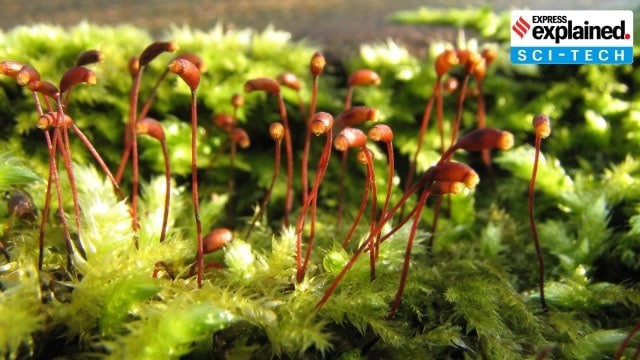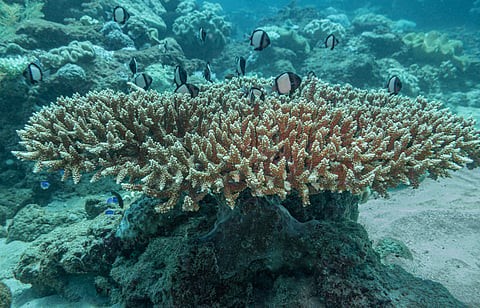





Copyright infringement not intended
Picture Courtesy: https://www.fao.org/newsroom/detail/new-global-fisheries-management-body-s-first-meeting-focuses-on-sustainable-practices-and-promoting-biodiversity/en
Context: The Food and Agriculture Organization (FAO) has released a new report on climate change risks to marine ecosystems and fisheries that provides a detailed projection of how global warming scenarios will impact exploitable fish biomass across different regions by the end of the century.
Key Highlights of the Report
|
Global Projections of Fish Biomass Decline |
●High-Emissions Scenario: By mid-century, global projections indicate declines of more than 10% in fish biomass across many regions. By the end of the century, these declines worsened significantly, reaching 30% or more in 48 countries and territories. This scenario assumes global warming of 3–4.0 °C. ●Low-Emissions Scenario: Under a more moderate global warming scenario of 1.5–2 °C, changes in fish biomass stabilize, showing either no change or a decrease of 10% or less across 178 countries and territories by the end of the century. |
|
Impact on Top Fish Producer Nations |
●Countries heavily reliant on fisheries, such as Peru and China, face notable declines in their Exclusive Economic Zones (EEZs) under the high-emissions scenario. For instance, Peru’s EEZ could see a decline of 37.3%, and China’s by 30.9%. These declines stabilize under the low-emissions scenario. |
|
Regional Variability |
●Small Island Developing States (SIDS): These regions, which depend significantly on fisheries for food security and income, are particularly vulnerable. The low-emissions scenario could mitigate extreme losses projected under high emissions by 68–90% in Pacific Island States like the Federated States of Micronesia, Nauru, Palau, Solomon Islands, and Tuvalu. |
|
Methodology and Research Framework |
●The report is based on the findings of the Fisheries and Marine Ecosystem Model Intercomparison Project (FishMIP), a global initiative involving state-of-the-art numerical models. ●FishMIP aims to provide policymakers with reliable projections on the long-term impacts of climate change on marine ecosystems and fisheries. |
|
Policy Recommendations |
●Climate Change Mitigation: Lowering emissions significantly reduces end-of-century biomass losses across most countries and territories compared to high emissions scenarios. This highlights the importance of climate change mitigation measures in safeguarding fisheries and aquatic food systems. ●Adaptation Strategies: The report emphasizes the need for adaptive fisheries management and broader agrifood policies that integrate marine resource management with freshwater and terrestrial systems. ●FAO’s Blue Transformation Vision: To achieve more resilient and sustainable aquatic food systems, FAO advocates for holistic management of marine natural resources, aligned with the FAO Strategy on Climate Change and its Action Plan. |
|
Future Directions |
●FishMIP2.0: Launched in 2024, FishMIP2.0 aims to enhance the reliability of model projections and address a wider range of policy-related questions relevant to food security and marine resource management under climate change. |
Fisheries and Marine Ecosystem Model Intercomparison Project (FishMIP)
Key Aspects of FishMIP
Contributions and Impact
Food and Agriculture Organization (FAO)
|
Mandate and Goals |
●Mission: The FAO leads international efforts to combat hunger, improve nutrition, and achieve food security for all. Its Latin motto, "fiat panis," translates to "let there be bread," encapsulating its mission to ensure regular access to high-quality food for everyone to lead healthy lives. ●Member Countries: The FAO comprises 195 member countries, including 194 countries and the European Union. This global membership highlights its mandate to work collaboratively across borders to address food and agricultural challenges. ●Headquarters: Located in Rome, Italy, the FAO operates from its headquarters and maintains regional and field offices worldwide. This extensive network allows it to provide technical assistance, conduct research, and coordinate development projects in over 130 countries. |
|
Structure and Governance |
●Governance: The FAO is governed by a biennial conference where each member country and the European Union are represented. This conference sets policies, reviews activities, and establishes budgets for the organization. ●Director-General: The Director-General serves as the chief administrative officer, responsible for implementing the policies and programs approved by the conference and council. ●Departments: The FAO operates through eight main departments, each focusing on specific aspects of agriculture, forestry, fisheries, climate, biodiversity, and economic development. These departments include Agriculture and Consumer Protection, Climate, Biodiversity, Land and Water Department, Economic and Social Development, Fisheries and Aquaculture, Forestry, Corporate Services, and Technical Cooperation and Programme Management. |
|
Activities and Initiatives |
●The FAO publishes several influential reports annually, including:
●The FAO has initiated significant programs and summits to address global food security challenges. For instance:
●Restructuring and Budget: In response to evolving challenges, the FAO underwent major restructuring in 1994 to decentralize operations, streamline procedures, and reduce costs. Its budget, funded by member contributions, supports core technical work, partnerships, and emergency assistance. |
|
Impact and Collaboration |
●Global Impact: The FAO's work influences global policies and practices related to agriculture and food security, advocating for sustainable practices and resilience in food production systems. ●Collaboration: It collaborates closely with sister UN agencies like the World Food Programme (WFP) and the International Fund for Agricultural Development (IFAD), along with governments, NGOs, and research institutions worldwide. |
Key programs and achievements of FAO
Conclusion
Must Read Articles:
The Impact Of Disasters On Agriculture And Food Security
Source:
Food and Agriculture Organization of the United Nations (FAO)
|
PRACTICE QUESTION Q. Sustainable fisheries management needs to consider the social and cultural well-being of fishing communities. How to ensure equitable access to fishing resources for different stakeholders and communities, particularly small-scale fishers who often rely heavily on these resources for their livelihoods? |







© 2025 iasgyan. All right reserved